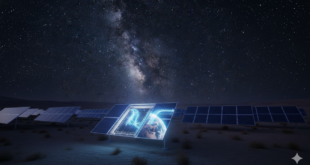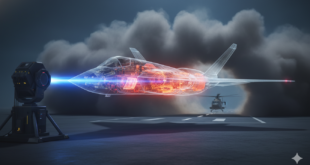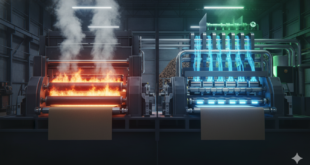Nuclear Propulsion: Powering the Future of Space Servicing, Mobility, and Logistics
Unlocking the next frontier in orbit and beyond—nuclear propulsion is redefining how we move, service, and explore in space.
As humanity ventures deeper into the cosmos, the need for more advanced propulsion systems to support Space Servicing, Mobility, and Logistics (SAML) missions has never been greater. With the limitations of traditional chemical propulsion systems, the next frontier for space exploration and infrastructure development lies in the adoption of nuclear propulsion technologies. These systems offer game-changing advantages that open up new possibilities for deep space exploration, satellite servicing, and interplanetary logistics. By providing unmatched energy density and efficiency, nuclear propulsion could usher in a new era of space architectures—one not constrained by the typical size, weight, and power (SWaP) limitations of current propulsion technologies.
The Promise of Nuclear Propulsion
Nuclear propulsion systems harness the power of nuclear reactions to generate thrust, providing a significant leap forward in terms of energy density when compared to conventional chemical propulsion. Chemical propulsion relies on combustion, which produces a limited amount of energy per unit of fuel, making it inefficient for long-duration missions that require vast amounts of fuel. In contrast, nuclear propulsion systems, such as Nuclear Thermal Propulsion (NTP) and Nuclear Electric Propulsion (NEP), utilize the immense energy released by nuclear reactions to offer greater fuel efficiency, which is crucial for deep space exploration and the servicing of satellites in high orbits.
Nuclear propulsion systems dramatically improve the ability of spacecraft to carry heavier payloads, perform complex orbital maneuvers, and reduce mission timelines. For example, NTP systems generate high thrust and are ideal for missions that demand fast, short-duration propulsion, such as crewed missions to Mars or asteroid mining. On the other hand, NEP systems provide continuous, lower-thrust propulsion, making them perfect for long-duration, deep-space missions where efficiency and endurance are paramount. Together, these systems offer the flexibility to tackle a wide range of mission profiles, from satellite maintenance to interplanetary exploration.
Transforming Space Logistics
One of the most exciting implications of nuclear propulsion is its potential to revolutionize space logistics. With the ability to transport heavier payloads and perform more complex maneuvers, nuclear propulsion will enable spacecraft to accomplish tasks that were once thought impossible. These include not only servicing existing satellites but also establishing infrastructure for space mining, asteroid harvesting, and building off-Earth colonies.
Currently, one of the most pressing challenges for space missions is the need for efficient transportation between Earth, low Earth orbit (LEO), geostationary orbit (GEO), and deep space. Traditional chemical propulsion systems, while effective for short missions, struggle to meet the growing demands of space logistics due to their limited efficiency and range. Nuclear propulsion systems could break this barrier by offering faster, more reliable, and cost-effective transportation for both crewed and uncrewed missions. Whether it’s resupplying lunar bases, transporting materials for space habitats, or enabling more efficient travel between planets, nuclear propulsion will be key to scaling up these operations.
Overcoming SWaP Constraints
The efficiency of nuclear propulsion also directly impacts the design and capabilities of spacecraft. One of the biggest challenges for spacecraft design has been the size, weight, and power constraints imposed by chemical propulsion systems. These limitations restrict the amount of scientific instruments, life support systems, or storage capacity that can be carried aboard a spacecraft, limiting the scope of missions.
Nuclear propulsion systems, by offering higher energy densities, allow spacecraft to be more compact and efficient. This means that future missions can accommodate a broader range of technologies and payloads, from advanced scientific instruments to larger crews. For example, lunar missions that require resupply or in-situ resource utilization could be more easily supported with nuclear propulsion, allowing spacecraft to make more frequent trips and carry heavier cargo. Similarly, satellite servicing and maintenance missions, which require precise maneuvering and repositioning in space, will benefit from the enhanced capabilities offered by nuclear propulsion.
U.S. Government’s Commitment to Nuclear Propulsion
In response to the growing interest in nuclear propulsion, the U.S. government has begun funding the development of various nuclear-powered spacecraft aimed at both civil and commercial applications. Lockheed Martin, a key player in this initiative, believes that nuclear propulsion technology will be crucial for military space operations once it matures. The company is on contract for several nuclear-powered spacecraft programs, each targeting different aspects of space propulsion.
These programs include efforts focused on fast transport through space, continuous power for lunar infrastructure, and innovative solutions for space servicing, mobility, and logistics (SAML) missions. Lockheed Martin is working on advanced nuclear thermal propulsion (NTP) and nuclear electric propulsion (NEP) technologies, such as the Demonstration Rocket for Agile Cislunar Operations (DRACO) program and the Joint Emergent Technology Supplying On-orbit Nuclear Power (JETSON) program. Both programs aim to push the boundaries of space propulsion, with DRACO planning an on-orbit demonstration of its nuclear reactor by 2027.
Additionally, the company is involved in NASA’s Fission Surface Power program, which will develop nuclear electric power systems to sustainably power lunar and Martian bases. These nuclear propulsion systems not only promise to enhance space exploration capabilities but could also enable military space operations by providing dynamic, fuel-independent mobility for satellites, which could be critical for responding to emerging threats in orbit.
The Role of Nuclear Propulsion in SAML Missions
Nuclear propulsion’s most compelling advantage for SAML missions lies in its ability to enable spacecraft to move freely through space without the constraints of fuel limitations. As satellites and other space vehicles currently have fixed fuel tanks and limited battery life, their ability to maneuver or adapt to new mission requirements is often restricted. Nuclear-powered spacecraft could overcome these limitations by offering dynamic propulsion capabilities that would allow satellites to move between orbits, perform multi-orbit missions, or even respond to unforeseen threats in space.
According to Jeff Schrader, vice president of global situation awareness at Lockheed Martin, the ability to move satellites to different orbits quickly could revolutionize satellite servicing and defense operations. The U.S. Space Command’s push for “dynamic space operations,” which refers to the ability to move satellites in orbit without being hindered by fuel or power constraints, aligns perfectly with the promise of nuclear propulsion.
Moreover, nuclear propulsion systems could be used for on-orbit servicing, such as docking with and refueling satellites to extend their operational lifetimes. This could significantly reduce costs for the government by extending the lifespan of existing satellites, making space operations more sustainable and cost-effective. This capability could be extended to commercial satellite constellations as well, opening up new opportunities for collaboration between the U.S. government and private industry.
Safety and Sustainability Challenges
While the potential of nuclear propulsion is enormous, the technology must overcome several hurdles before it can be fully operational. The challenges related to safety, radiation shielding, and environmental impact are significant, especially for military applications. Ensuring that these systems can operate reliably in space while protecting crew and spacecraft from radiation is a key focus for developers. Additionally, the regulatory landscape surrounding the use of nuclear propulsion in space must be adapted to accommodate these new technologies.
The Road Ahead
As space missions become more ambitious and complex, nuclear propulsion technologies will play an indispensable role in the future of space exploration. The ability to move heavier payloads, reduce mission durations, and create more flexible spacecraft designs will unlock the potential for a wide range of SAML missions. With nuclear propulsion, we can look forward to a future where space logistics, satellite servicing, and interplanetary exploration are no longer constrained by the limitations of traditional propulsion systems.
Lockheed Martin and other key industry players are working to ensure that nuclear propulsion systems are ready for operational use by the 2030s. As research and development continue to refine these technologies, the dream of a sustainable, interconnected space economy is becoming increasingly achievable, with nuclear propulsion at the core of this transformation.
References and Resoures also include:
https://defensescoop.com/2024/04/15/lockheed-martin-nuclear-powered-spacecraft-defense/
 International Defense Security & Technology Your trusted Source for News, Research and Analysis
International Defense Security & Technology Your trusted Source for News, Research and Analysis




